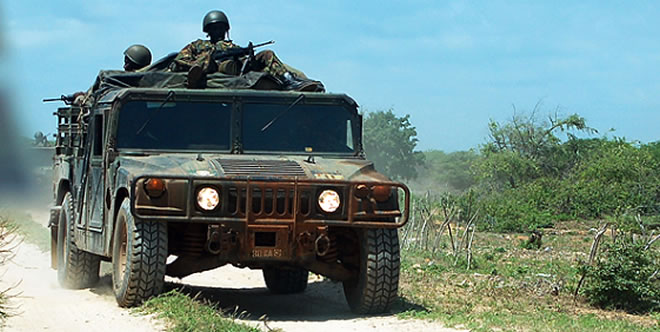
A Kenya Army jeep at the Ishakani border point in Kiunga as it heads for the battlefront in Somalia- Laban Walloga | Nation
Bloomberg BusinssWeek
By David Malingha Doya
Tuesday, July 23, 2013
When Kenya sent troops to Somalia in October 2011 to fight al-Qaeda-inspired al-Shabaab militants, it vowed to pull them out by Christmas. More than 20 months on, there’s no sign they’ll leave soon.
Kenya’s 700-kilometer (435-mile) eastern border is full of menace: from the south near the Somali port of Kismayo that’s in striking distance of its white-sand beaches, to the arid northeast, which has been hit by bombings, kidnappings and clan violence over politics, land and water. Zaddock Syong’oh, a Kenyan Foreign Ministry policy adviser, says Kenya won’t pull out until Somalia is stable.
The longer Kenya stays, the weaker its relations with the Somali government. It backs the creation of a semi-autonomous state of Jubaland in the south as a buffer zone along its border. Somalia has asked Kenyan troops to withdraw from Kismayo, saying they backed a militia involved in fighting last month that the United Nations says killed 71 civilians.
“If Kenya makes a hasty decision to pull out, we will go back to square one with al-Shaabab returning to Jubaland, because the current government doesn’t have the capability to keep them out yet,” Rashid Abdi, a Nairobi-based Somalia analyst, said in a phone interview July 22. “Al-Shabaab has been degraded but not totally defeated.”
Somalia Security
The authorities in the capital, Nairobi, dispatched troops to Somalia after they blamed a series of kidnappings of foreigners and the murder of a British tourist in Kenya on al-Shabaab. Tourism competes with tea and horticulture as the biggest source of foreign exchange for East Africa’s largest economy. More than half a million mainly Somali refugees live in the United Nations-run Dabaab camp in northeastern Kenya.
While Kenya initially sent troops of its own accord, the UN decided in February 2012 to absorb them into the African Union force. They now number 4,040 and join 6,223 Ugandans, 5,432 Burundians, 850 from Sierra Leone and 999 from Djibouti, according to the AU.
“Kenya’s security along the border with Somalia is intractably linked to peace and stability in that country,” Syong’oh said in a July 12 interview in Nairobi. “Kenya’s military will not therefore leave Somalia until it is stable and secure.”
In the northeast, Kenya is concerned that clan violence fueled by instability in Somalia may jeopardize future exploration for oil and the planned LAPSSET transportation corridor to link Ethiopia and newly independent South Sudan to the port of Lamu.
Illegal Arms
A Kenyan panel investigating clashes in the Tana River coastal region that left 164 people dead since last year said the flow of illegal arms from Somalia played a part in fueling the violence. The feuding communities of the Pokomo farming community and the Orma, who are nomadic livestock herders, got weapons from arms traders on the Somali border, it said.
For now, Kenyan forces operate mainly in the south near Kismayo, which served as a supply route and a key source of the estimated $50 million a year the al-Shabaab militia earned from taxes on Somalia’s harbors before it fled the city in October.
Somalia’s federal government, which is making a 16th attempt to impose a central administration on the Horn of Africa nation since former dictator Mohamed Siad Barre was ousted in 1991, doesn’t control the southern region of Kismayo, according to the London-based Chatham House research group.
Kismayo Fighting
The renewed fighting in Kismayo started after regional delegates attending a May 15 conference elected the head of the Ras Kamboni militia, Sheikh Ahmed Mohamed Islam, who’s also known as Madobe, as leader of Jubaland in a process backed by Kenya, according to Syong’oh. Shortly afterward, Barre Adam Shire Hirrale, a former Somali defense minister, declared himself president of the region, according to the African Union.
“The crisis in Kismayo has the potential to undermine the nascent Somali federal government,” Ahmed Soliman, Horn of Africa analyst at Chatham House, said in an e-mailed response to questions. “It also threatens the fragile recovery of the country by balkanizing southern Somalia, and creating an opening for al-Shabaab to reassert control in recently recovered areas.”
Kenya regards Kismayo as strategic because of the port and its proximity to the heart of its tourist trade on the Indian Ocean coast. Control of the city also gives access to Somalia’s most fertile lands in Lower Jubaland, and abundant marine resources including probable oil deposits, according to Soliman.
Jubaland Wealth
“Jubaland is the wealthiest region in Somalia and has been the country’s bread basket for centuries,” Abdi said. “It has huge agricultural potential, marine resources and potential for finding hydrocarbons.”
Some Kenyan business people, aided by Madobe’s Ras Kamboni militia, may have benefited from Kismayo too through selling charcoal at a time when the trade has been banned by the Somali government and the UN, Soliman said. The interim Jubaland administration denies involvement in the business, according to a July 16 e-mailed statement.
About 4 to 6 million metric tons of charcoal that may be worth as much as $40 million are piled up at the port in Kismayo due to the trade ban, he said.
“The dispute on Kismayo is hugely distracting the struggle against al-Shabaab,” Abdi said. “Although al-Shabaab is weak and fragmented, they are looking, and will capitalize on any opportunity to return to the region.”
To contact the reporter on this story: David Malingha Doya in Nairobi at [email protected]
To contact the editor responsible for this story: Paul Richardson at [email protected]